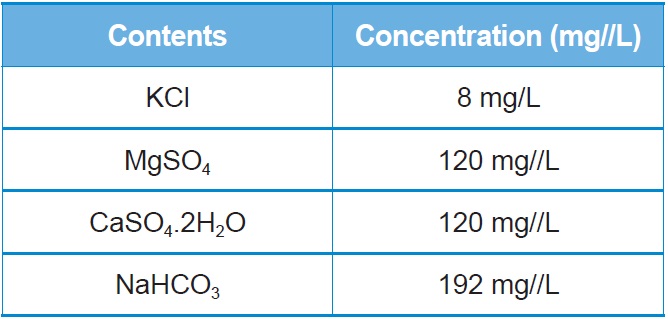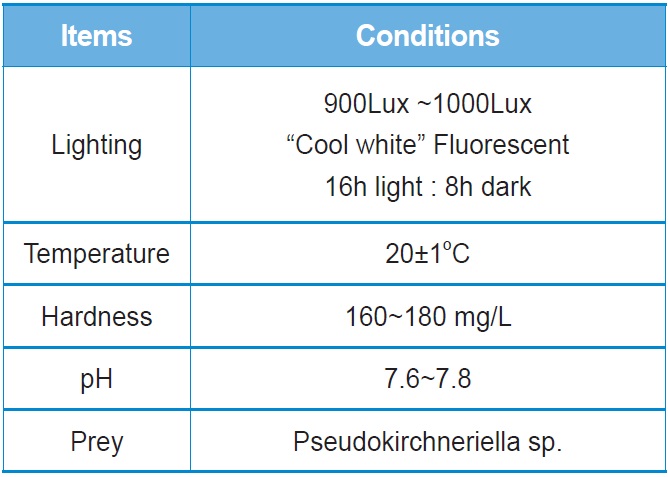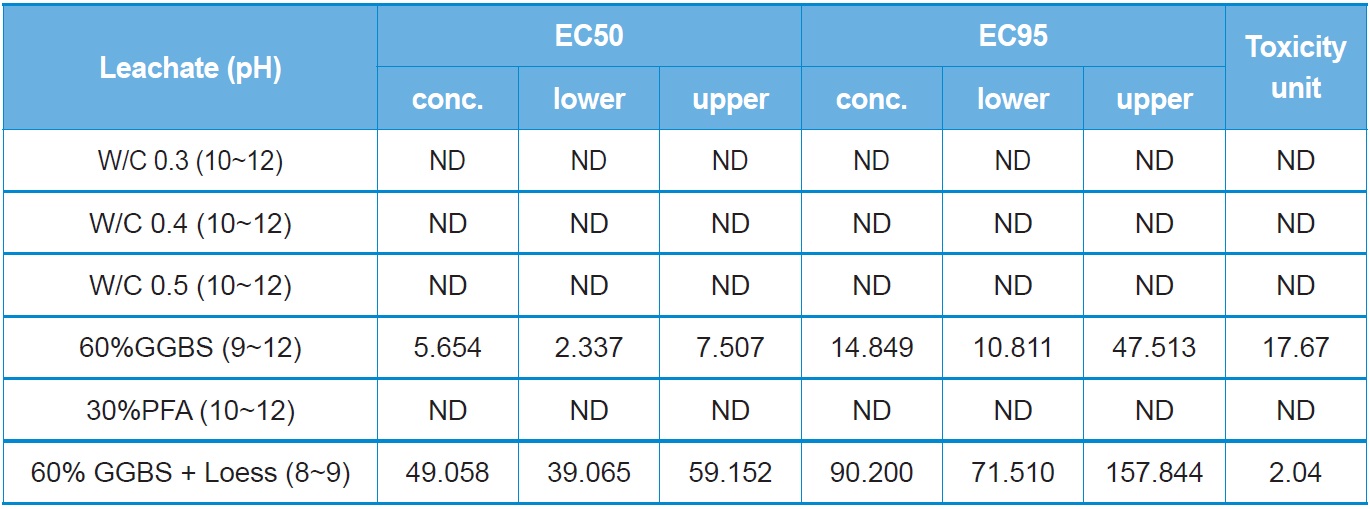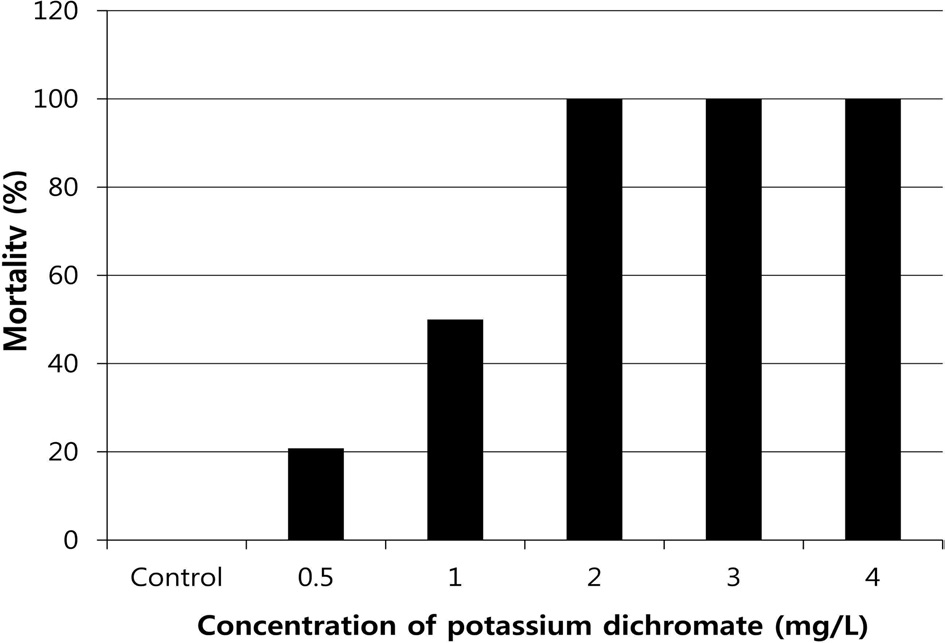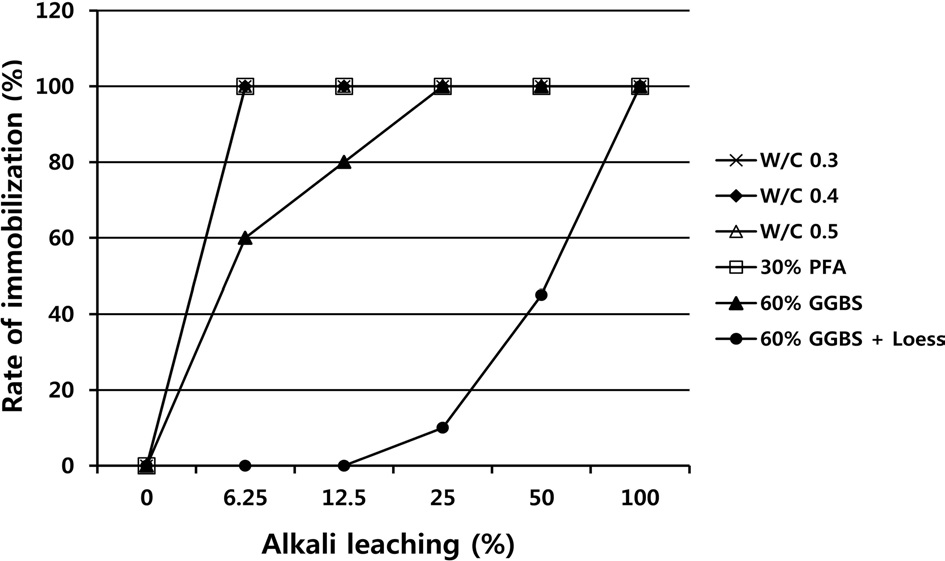The detection and presence of toxic materials in environment is one of the most popular interests because of their harmful effects on ecosystem including human. Especially, the presence of toxic materials in aquatic environment is more considerable to evaluate the harmfulness. The evaluation of contamination in aquatic environment has been for a long time performed only by specific chemical analyses, but many experiences and studies have shown the inadequacy of such approach. To complement this chemical analysis, the biological methods using fish or algae have been used to evaluate and monitor the water quality for many years (Sandbacka et al., 2000; Versteeg et al., 1997). The cladoceran Daphniamagna Straus has been used as a “standard” aquatic test species among cladoceran and most frequently used for chronic and acute tests in aquatic toxicology (ASTM, 1987; EEC, 1992; OECD, 1992). Many countries are using aquatic toxicity tests as part of their water quality monitoring program (Slabbert and Venter, 1999). In Korea also, the D. magna has been used for the assessment of toxicity in aquatic environment from 2011 (KEC).
The D. magna is a species of Daphnia and distributed in North America, Eurasia and some regions of Africa. This has many advantages as an experimental animal like as small, short life span and easy culture (Martins et al., 2007). They can be grown in small bottle or in mass culture in water containing bacteria or their equivalent for food. Daphnia provide enough satisfactory for toxicity testing because they are food for many fish, fishes do not survive long in waters where their food supply has been destroyed.
The concrete is composed of primarily of cement, aggregate, and water and is widely used for making architectural structures, foundations, walls, bridges, dams and etc. Especially, the cement, commonly Portland cement, serves as a solidified and hardened into rock-hard strength through a chemical process. Concern about the environmental impacts of cementbased materials has been grow consistently now (Dell'Orso et al., 2012; Napia et al., 2012). As organic components in cement are usually burned away during formation process, they are not considered carefully with harmful materials. The primary interest of cement-based materials for the environmental impacts is the leaching of inorganic compounds when they are contact with waters (Napia et al., 2012). The cement contains heavy metals and other toxic inorganic components. These components act as toxic materials in environment when they are released by water. Therefore, many studies have been focused to prevent or reduce the release of them to environment (Brunori et al., 2001; Dell'Orso et al., 2012; Napia et al., 2012). Additionally, the alkali leaching from concrete by contacting water is most serious inorganic component, but its assessment for environment has not been studied yet. The alkali leaching is not only problem to architectural structures but also more serious to the construction of bridges, dams and other offshore structures (Van Gerven et al., 2007; Mohamed and El Gamal, 2011).
The purpose of this study, therefore, was to evaluate the usage of eco-toxicity assays with D. magna in water contaminated with alkali leaching of concrete. To reduce toxicity, in additionally, the effect of loess as the eco-friend admixture was evaluated.
Daphniamagna was obtained from Korea Environment
Corporation (KEC), Korea, and maintained in laboratory by the standard culturing method suggested by KEC (Table 1) (KEC). The synthetic hard water for culture was manufactured as Table 2. Daphnia magna was cultured individually in 100 ml glass beaker containing hard water and fed with 2~2.8 × 105 cells/15 ml concentrated algal solution of Pseudokirchneriella sp.
The alkali leaching specimen was prepared from the mixture of Ordinary Portland Cement (OPC) and pozzolanic admixture. The specimens were made with not only cement and water but also the admixture instead of cement. The ratio of cement to water was 10:3, 10:4 and 10:5, respectively. The admixture replacement percentage were followed in the 10:4 ratio of cement to water; 30% Pulverised fuel ash (PFA), 60% Ground granulated blast furnace slag (GGBS) and 60% GGBS containing loess, respectively. Each specimen was treated to the sealed container filled with water for 30 days, and then the leachate was prepared from it.
As a means of controlling the sensitivity of D. magna and the reliability of the experimental protocol, an internal control test was performed with each series of tests in standard test conditions; potassium dichromate (K2Cr2O7) was used as a reference toxicant. The test was performed with nominal concentrations of 0.5, 1.0, 2.0, 3.0 and 4.0 mg/L. In each test item concentration four replicates were maintained and each containing 5 neonates in 50 ml of medium. The immobilized or died neonates were recorded at 24 hrs of exposure. EC50 values to D. magna were determined by probit analysis (Finney, 1971). Whenever the EC50 value of D. magna fell outside the allowed range, the data of the entire test series were considered unacceptable and the experiment was repeated.
All experiments were carried out with brood neonates (< 24 hrs old). Twenty D. magna per treatment were used and not fed during tests. Temperature and photoperiod were as described in Table 2. The test solutions were diluted by hard water with concentrations of 100, 50, 25, 12.5 and 6.25%. In each concentration four replicates were performed and each containing 5 neonates in 50 ml of test solution. The measured effect was recognized as immobilization for 15s after stimulation by a bright light under microscope. After determining 24-h EC50 value, toxicity unit (TU) was calculated as follows, TU = 100/EC50 (Ra et al., 2008).
To evaluate the reliability of the experimental protocol for acute toxicity test, the standard toxicity test was carried out using potassium dichromate. As the result, EC50 value was 1.01 mg/L at 24 hrs of exposure (Fig. 1). This value belonged to normal range (0.9~2.1 mg/L)
of standard toxicity test using D. magna (KEC). This result indicated that the culture condition of D. magna and the experimental protocol are enough to satisfy the reliability of acute toxicity test.
The effect of alkali leachate from various kind
of concrete to D. magna was determined by acute toxicity test. The result showed 100% immobilization of D. magna when treated with leachates from the OPC only used concrete in all concentrations (Fig. 2). This indicated that the highly toxic materials are leached from OPC. Additionally, as the pH of leachates from OPC was high from 10 to 12, we could not exclusive possibility that this high pH may be the lethal factor because the survival tolerance pH is 7 to 8.5 generally for organisms including Daphnia (Table 3). The leachate from concrete replaced with PFA 30% also showed 100% immobilization and high pH (10-12) in all concentrations. However, the replacement of OPC with GGBS 60% was effective to reduce the toxicity. Immobilization was 100% at the concentrations of above 25% of leachates from GGBS but was 60 and 80% at the concentrations of 6.25 and 12.5%, respectively. Although the leachates from GGBS showed high pH range (9-12) and this pH range was also inappropriate for the survival of D. magna, the survival rate was increased (Fig. 2). This result suggested that the lethal factor of D. magna is not only the high pH but also other toxic materials from OPC, PFA or GGBS. Because GGBS was less toxic to D. magna, the leachate was prepared from the concrete containing GGBS 60% and loess which is known as eco-friendly material. As the result, immobilization was observed at the concentration of 25, 50 and 100% of leachates with 10, 45 and 100%, respectively. The pH of leachates from this concrete was also decreased to 8-9. This result indicated that the addition of loess can reduce the pH and aquatic toxicity significantly.
From the preceding results, 24h-EC50 value and TU were calculated (Table 3). We could not determine any value of 24h-EC50 value and TU for the leachates from OPC only or replacement with PFA 30% because of their high toxicity. The replacement with GGBS 60%, on the other hand, showed 17.67 TU and the addition of loess, especially, reduced TU significantly to 2.04.
The amount of leaching from concrete used in this study may be much more than that from natural condition because the less water used to leach from concrete in this study. However, 100% immobilization in all concentrations of OPC or PFA 30% suggested that the effects of leachates from concrete in natural condition may be significant in aquatic environment. The strength of concrete is determined generally by the rate of cement to water. Therefore, the use of higher amount of cement in mixture is the basic essential to satisfy strength of concrete. Acute test showed significantly high toxicity to D. magna at the 10 to 4 ratio of cement to water which is generally used ratio in concrete (Fig. 2, Table 3). This result suggests that the development of methods to reduce the amount of cement in concrete or the alkali leaching from concrete is required for the aquatic environment. The use of PFA and GBBS as replacement of cement were not also effective to reduce the toxicity of leachate. The GBBS containing loess, however, showed remarkable effect to reducing toxicity. Loess has been used traditionally in construction of architectural structures in Korea and is considered as eco-friendly material (Kim et al., 2007). As the similar material with loess, there are several reports about the effects of metakaolin for the enhancement of durability and strength of concrete (Cyr et al., 2102; Gallego-Perez et al., 2011; Lau et al., 2003). Metakaolin is made from kaolin, and its effects for concrete are valid after activation of kaolin. Similar effects of loess were also reported in Korea (Kim et al., 2007). Loess was not useful for concrete as itself, but it was effective after activation of loess by heat treatment. The use of loess as the replacement of cement in concrete, therefore, may be useful to reduce eco-toxicity of leachates from concrete after further study of loess as admixture in concrete.
In conclusion, this study provided the harmfulness of the alkali leaching from concrete in aquatic environment and the usefulness of D. magna to evaluate the toxicity of leachates from concrete.




